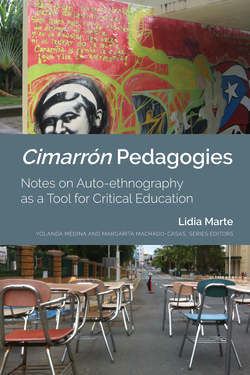Читать книгу Cimarrón Pedagogies - Lidia Marte - Страница 13
На сайте Литреса книга снята с продажи.
Framings and Common Grounds
ОглавлениеWhat we do in the classroom is not a rehearsal; it is real life. Learning happens spontaneously in everyday life; it is through such ongoing process of socialization that we are “domesticated” into becoming culturally specific humans. Formal education, however, happens mostly through “conscious” learning efforts and through problematic and contested institutional spaces, sites of great vulnerability, but also of great opportunity, especially for college students “of color.” The structure, disciplining practices and ideologies that circulate—and are reproduced—through these spaces shape profound transformations in our ways of perceiving, understanding and taking action.
The practices of a “banking education” identified by Paulo Freire (2000) are the standards in most college classrooms, where the student is a passive being to be molded, or a recipient to be filled with information, to later regurgitate in an exam. These practices are costly and ineffective for all students and are particularly damaging and catastrophic for students who come from marginalized communities, ←1 | 2→all minorities, queer groups, immigrant communities, and for students coming from any colonized memory-histories. Students who come from such communities or “minoritized” social groups, frequently find, in the colleges they attend, a toxic environment of rejection where they do not feel valued but rather pathologized; this is usually expressed through stereotypes, prejudices and racist micro-aggressions (see Duncan 2005, Yosso 2005, Delgado 2013). These conditions aggravate their already challenged sense of self-worth and trust in their intelligence, capacities and talents. Self-esteem, in this sense, is rather a socio-cultural and historical issue rather than only a psychological one. Opposed to this ethnocentric and colonial pedagogy, Freire—and many others after him—proposed a critical pedagogy praxis, where being awake and responsive is the start of participatory learning and a democratic dialogue. Rather than discarding previous experience and cultural knowledge, a critical pedagogy creates space to first discover what kinds of filters students bring to class, to identify, evaluate, integrate and help transcend—through radical imagination—existing limitations, gaps and boundaries, according to the students’ abilities, interests and life projects.
Yet, like going to the bathroom, no one can teach anyone critical (or creative) thinking; all we can do is to identify certain tools and resources to share with students, create spaces of dialogue in the classroom to allow for understanding to happen, explain how to apply certain concepts to interpret our everyday realities, create assignments through which students have a chance to test-drive those tools, evaluate their learning process, and then, hope for the best. Only students themselves can test-drive the new tools and knowledge, so they can get to know and modify them according to their educational goals, to their own needs and current challenges. We cannot liberate anyone either, from external or internal oppressions, but we can share with students the legacy and strategies of those who have found a way to de-colonize their minds and their personal lives, and who have joined others in collective liberations. We, as teachers, need to learn to trust our students’ capacity to find—and hold with passion to that—what they most need to learn for their own projects of liberation.
Giving students the opportunity to explore where they are located as social agents in-place and how to examine and value their experiences, help them generate skills to navigate the private-public thin divide through which all humans negotiate our survival and our life projects. Researching where and when they are, recognizing the macro-narrative frames that shape their micro-narratives and ideologies, and practicing documenting the cultural histories that made them possible, help them obtain the mastery of what we want them to learn, but through a different route, a personal grounded investment, which has more profound and lasting benefits. Thus, we can help students discover their strength and their “marronage ←2 | 3→potential” even under the most restricted and challenging situations. Yet, before new knowledge can be integrated, and new methods and theories mastered, students need to develop “a critical praxis” (an embodied new perspective, not only a mode of “thinking,” as if they were an isolated brain). Learning is a synergistic process of experience, of feeling, thinking and imagining.
The suggestive framing of this book as “cimarrón pedagogy,” proposes going beyond critical education, to a radical strategy of engagement beginning from the personal grounds of where our students are. This approach is a way of recycling and celebrating ethno-historical strategies of liberation, as an ongoing project for which much work is still needed, including traveling the long global history of Afro-diasporic communities in their educational struggles and contributions. The word Cimarrón (maroon) was used in the Hispanic Caribbean to name run-away goats, pigs, enslaved indigenous groups and later enslaved indigenous Africans and their descendants brought to the Americas in the Atlantic Slave Trade. Likewise, cimarronaje/marronage was used to name any petit or grand act of resistance to colonial rule. Extending marronage as a historical instance, we can use this term as a metaphor to speak of our intentions for a liberation pedagogy.
Given the conditions in most colleges and schools where we teach and the prevailing banking education visions in our societies, creating more safe spaces for dialogue, human dignity and liberation in our classrooms is a cimarrón act. I echo bell hooks’ calling for finding pleasure and excitement in teaching for liberation, to which I would add the necessity of humor and poetics when teaching difficult matters. This approach balances the burden of addressing so much suffering, trauma and violence, but it also best represents the contradictory complex politics of our human experiences.
The hegemonic discourses of a western education imposed in the Americas had their inherent cultural ethnocentrisms, their symbolic violence and their class marks. Trying to create a space of human dignity and liberation in our classrooms is, hence, a cimarrón de-colonizing first step into practicing—until we get it right—viable forms of participative democracy and new forms of learning communities.
